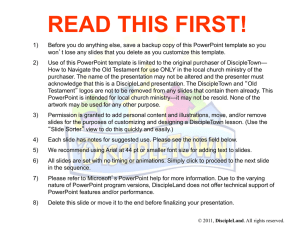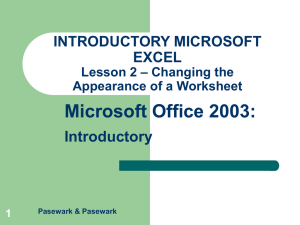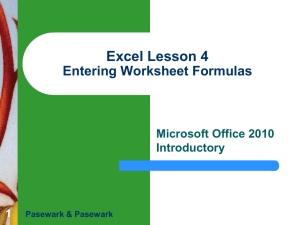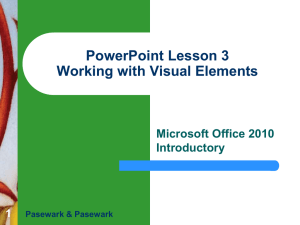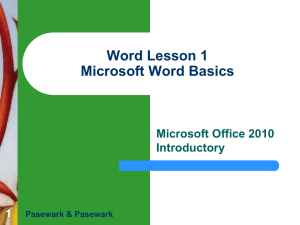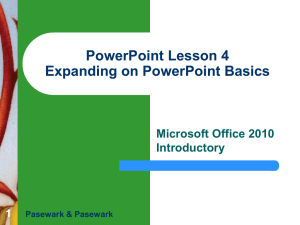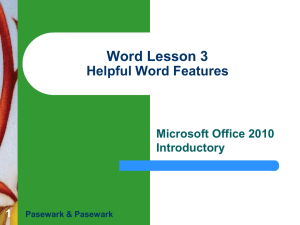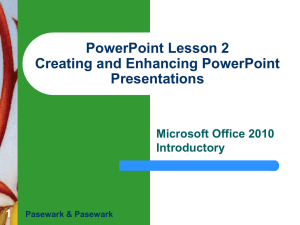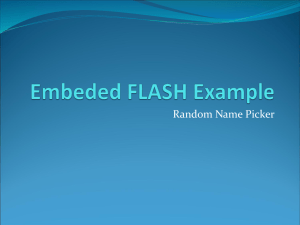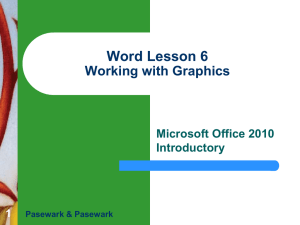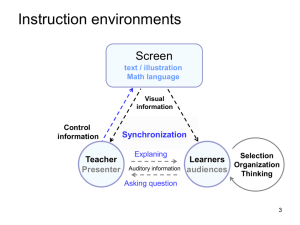PowerPoint Lesson 1 Microsoft PowerPoint Basics
advertisement
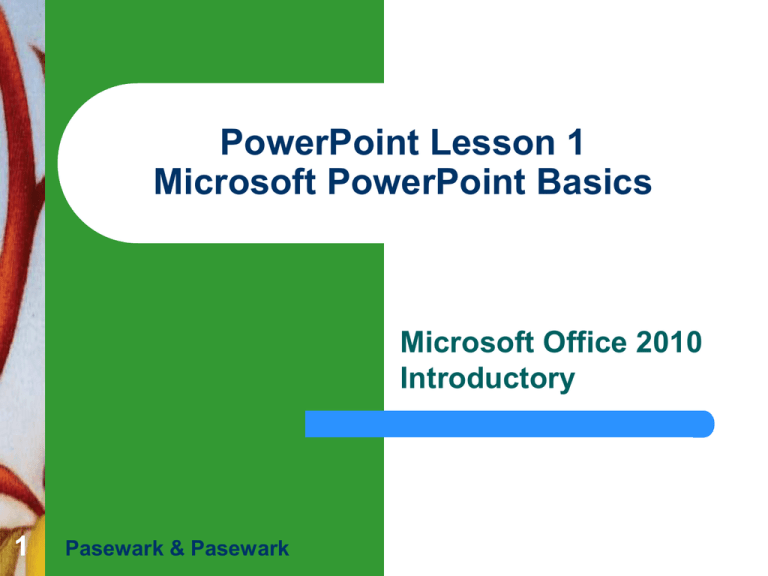
PowerPoint Lesson 1 Microsoft PowerPoint Basics Microsoft Office 2010 Introductory 1 Pasewark & Pasewark Objectives PowerPoint Lesson 1 2 Start PowerPoint, and understand the elements of the PowerPoint window. Open an existing presentation, and save it with a new name. Navigate a presentation and change views. Use the Slides and Outline tabs and the Slide and Notes panes. Pasewark & Pasewark Microsoft Office 2010 Introductory Objectives (continued) PowerPoint Lesson 1 3 Change the layout on a slide. Delete a slide. Print a presentation. Exit PowerPoint. Pasewark & Pasewark Microsoft Office 2010 Introductory Vocabulary PowerPoint Lesson 1 4 animation broadcasting handouts layout Live Preview Normal view Notes Page view Notes pane Outline tab Pasewark & Pasewark PowerPoint presentation Reading view Slide pane Slide Show view Slide Sorter view Slides tab thumbnails transition Microsoft Office 2010 Introductory Introduction to PowerPoint PowerPoint Lesson 1 PowerPoint is a program used to create professional presentations. Presentations can include: – – – – – 5 text graphics tables charts audio – – – – – Pasewark & Pasewark video flash animation files animated clip art movie clips links to Web sites Microsoft Office 2010 Introductory Starting PowerPoint PowerPoint Lesson 1 6 Click the Start button on the taskbar. Click All Programs on the Start menu. Click the Microsoft Office folder. Click Microsoft Office PowerPoint 2010. Pasewark & Pasewark Microsoft Office 2010 Introductory PowerPoint Lesson 1 Reviewing the PowerPoint Window 7 The PowerPoint window shares several common elements and tools with other Office programs. Normal view allows you to add and delete slides, and add text and elements to slides. The Home tab is the default tab on the Ribbon and includes many of the commands you will use most often. Pasewark & Pasewark Microsoft Office 2010 Introductory Reviewing the PowerPoint Window (continued) PowerPoint window in Normal view PowerPoint Lesson 1 8 Pasewark & Pasewark Microsoft Office 2010 Introductory Opening an Existing Presentation and Viewing a Slide Show PowerPoint Lesson 1 9 To open a recently viewed presentation, you can choose the presentation from the Recent Presentations list in Backstage view. To view the presentation as a slide show, click the Slide Show button on the status bar. Pasewark & Pasewark Microsoft Office 2010 Introductory Opening an Existing Presentation and Viewing a Slide Show (continued) PowerPoint Lesson 1 10 A slide show is a series of slides. Transition refers to the way each new slide appears on the screen. An animation is an effect you can apply to text, objects, graphics, or pictures to make those objects move during a slide show Pasewark & Pasewark Microsoft Office 2010 Introductory Opening an Existing Presentation and Viewing a Slide Show (continued) Title slide for Tornadoes presentation PowerPoint Lesson 1 11 Pasewark & Pasewark Microsoft Office 2010 Introductory Saving a Presentation PowerPoint Lesson 1 12 To save a new presentation the first time, you use the Save As command. The next time you want to save changes to your presentation, click the Save button on the Quick Access Toolbar or press Ctrl+S. Pasewark & Pasewark Microsoft Office 2010 Introductory Saving a Presentation (continued) Save As dialog box PowerPoint Lesson 1 13 Pasewark & Pasewark Microsoft Office 2010 Introductory Changing Views PowerPoint Lesson 1 14 You can view a presentation in five ways: – – – – – Normal view: Where you do most of your work. Reading view: Slide almost fills screen. Slide Sorter view: Displays thumbnails of your slides so you can easily rearrange them. Slide Show view: Your presentation is shown full screen as if being seen by an audience. Notes Page view: Displays slides on top of the page and speaker notes below. Pasewark & Pasewark Microsoft Office 2010 Introductory Changing Views (continued) PowerPoint Lesson 1 15 To change views: – Go to the Presentation Views group on the View tab. – View shortcuts on the status bar. Pasewark & Pasewark Microsoft Office 2010 Introductory Changing Views (continued) PowerPoint Lesson 1 16 In Normal View you can have up to four panes: – – – – – Slides tab and Outline tab: Slides tab shows thumbnails of your slides and Outline tab shows text in an outline format. Slide pane: Displays one slide at a time, and offers an opportunity to edit text. Notes pane: Where you add speaker notes. Task pane: Opens up on the right for some tasks such as inserting clip art. . Pasewark & Pasewark Microsoft Office 2010 Introductory Changing Views (continued) PowerPoint Lesson 1 17 The Ribbon contains commands for the tasks you will use when creating presentations. The Live Preview feature lets you preview a theme before applying it in your presentation. The Slide pane is the workbench for PowerPoint presentations, displaying slides in a large work area. Pasewark & Pasewark Microsoft Office 2010 Introductory Inserting a New Slide with a New Slide Layout PowerPoint Lesson 1 18 You can choose a layout when you insert a new slide or change the layout of an existing slide. – – – Slide layout: How objects are placed on a slide. Objects: Text, images, illustrations, tables, media, and charts. Default layout: Includes placeholders for titles, text, and content. Pasewark & Pasewark Microsoft Office 2010 Introductory Inserting a New Slide with a New Slide Layout (continued) Default layouts PowerPoint Lesson 1 19 Pasewark & Pasewark Microsoft Office 2010 Introductory Notes Page View PowerPoint Lesson 1 20 Notes Page view displays your slides on the top of the page, with speaker appearing in the Notes pane on the bottom of the page. – – You can use the notes to help guide you during the presentation. Notes are also helpful if you print a handout for your audience. Pasewark & Pasewark Microsoft Office 2010 Introductory Using Slide Sorter View PowerPoint Lesson 1 21 Slide Sorter view displays thumbnails of the slides so that you can move and arrange slides easily by clicking and dragging. Slide Sorter view gives you an overview of the entire presentation. Pasewark & Pasewark Microsoft Office 2010 Introductory Using Slide Sorter View (continued) Slide sorter view PowerPoint Lesson 1 22 Pasewark & Pasewark Microsoft Office 2010 Introductory Using Slide Show View PowerPoint Lesson 1 23 In Slide Show view, you run your presentation on your computer as if it were a slide projector. Each slide fills the screen and any animations, sounds, and videos included in the presentation play. Pasewark & Pasewark Microsoft Office 2010 Introductory Using Slide Show view (continued) PowerPoint Lesson 1 Move the mouse to the lower-left corner of the screen as the slide show runs to access Slide Show toolbar. Commonly-used commands in Slide Show view 24 Pasewark & Pasewark Microsoft Office 2010 Introductory Using Reading View PowerPoint Lesson 1 25 In Reading view, the slide does not quite fill the screen and displays navigation buttons. Slide in Reading view Pasewark & Pasewark Microsoft Office 2010 Introductory Deleting Slides PowerPoint Lesson 1 26 In Normal view, display the slide you want to delete, press Delete on the keyboard. You can also delete a slide, by right-clicking the slide, then click Delete Slide on the shortcut menu. If you accidentally delete a slide, click the Undo Delete Slide button on the Quick Access Toolbar to restore the slide. Pasewark & Pasewark Microsoft Office 2010 Introductory Printing a Presentation PowerPoint Lesson 1 27 PowerPoint offers several print options, including: – – – Print all slides or a text outline of your presentation. Print handouts with 2 to 9 slides per page. Print only the current slide, or any combination of slides in your presentation. Pasewark & Pasewark Microsoft Office 2010 Introductory Printing a Presentation (continued) Print options PowerPoint Lesson 1 28 Pasewark & Pasewark Microsoft Office 2010 Introductory Closing a Presentation and Exiting PowerPoint PowerPoint Lesson 1 29 Click the File tab In the navigation bar, click Exit, or click the presentation window Close button. Pasewark & Pasewark Microsoft Office 2010 Introductory PowerPoint Lesson 1 Summary 30 In this lesson, you learned: PowerPoint is an Office application that can help you create a professional presentation. When you start PowerPoint, you have the choice of opening an existing presentation or creating a new one. You can view your presentation in five different ways: Normal view, Slide Sorter view, Slide Show view, Reading view, and Notes Page view. Each view has its own advantages. You can insert slides, add text and objects to slides, and delete slides as you work to create the presentation. Pasewark & Pasewark Microsoft Office 2010 Introductory Summary (continued) PowerPoint Lesson 1 31 To view the presentation with animations and transitions, you use Slide Show or Reading view. A slide show can advance automatically or by clicking or pressing specific keys on the keyboard. You can print your presentation as slides using the Slides option, with notes using the Notes Pages option, or as an outline using the Outline View option. You can also choose to print handouts with two, three, four, six, or nine slides per page. To exit PowerPoint, click the File tab on the Ribbon, and then in the navigation bar, click Exit. Pasewark & Pasewark Microsoft Office 2010 Introductory
